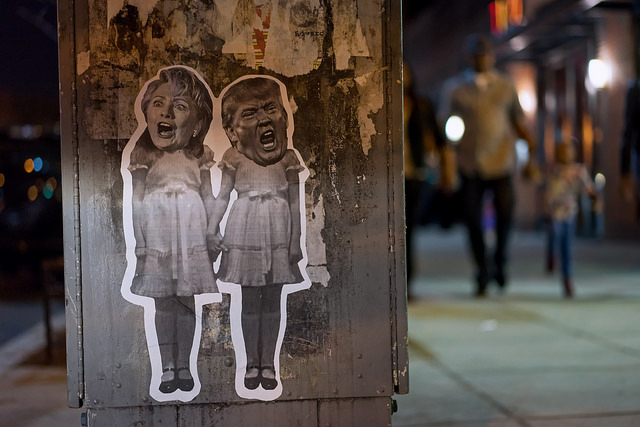Election 2016: Who does this country hate less?
We’ll meet our fate on November 8
In only a few short weeks, we — as a nation — will head to the polls to vote for the next president of the United States.
And if we’ve learned anything from this election, it’s that pretty much anything goes.
Last week, the New York Times wrote of the “risks and rewards” of the upcoming presidential election, noting the race is dangerously close. According to the story, voters dislike the candidates equally. A poll done by The New York Times and CBS News showed 33 percent of people polled found Democratic nominee Hillary Clinton trustworthy, while 35 percent thought the same of Republican nominee Donald J. Trump.
But the candidates are not neck and neck in all instances. In the same poll, 55 percent of people said they believe Clinton has an appropriate temperament and personality to be president, while only 31 percent of those polled thought the same about Trump.
Forty-eight percent of people polled said they thought Trump could bring real change to Washington politics. Only 36 percent said they thought Clinton could do the same.
The article also said 87 percent of Democrats support Clinton, while 85 percent of Republicans support Trump.
Needless to say, this election cycle is a close one.
To complicate matters further, third party candidates— Libertarian candidate Gary Johnson and Green Party candidate Jill Stein — are throwing a wrench into the polls.
According to The New York Times, “polling and other research” done by Priorities USA Action, the principal super PAC supporting Clinton, found many who vote for third-party candidates do so because they hate Trump and dislike Clinton. And according to the research, those third-party voters probably won’t embrace the Democratic candidate.
Priorities USA strategist Justin Barasky called for action on this issue.
“We’ll be launching a multimillion-dollar digital campaign that talks about what’s at stake and how a vote for a third-party candidate is a vote for Donald Trump, who is against everything these voters stand for,” Barasky told the New York Times.
Former Vice President Al Gore also spoke out against the dangers of splitting the vote to the New York Times.
“I can assure you from personal experience that every vote counts,” Gore wrote in an email to the New York Times. “The stakes are high for so many Americans. So I will vote for Hillary Clinton and I strongly encourage others to vote for her as well.”
But does your vote really count?
Well, yes and no.
As Gore knows better than anyone, the popular vote doesn’t win the presidency — the states do.
So what it comes down to is whether your preferred candidate is the candidate the majority of your state prefers. Aside from polling, it can be easy to predict which state is voting red and which is voting blue. Massachusetts, for example, historically votes Democrat, thus labeling us as a blue state.
History has a tendency to repeat itself. And according to the most recent poll done by WBUR and MassINC, Clinton has a 23-point lead over Trump in Massachusetts.
But the real contest will be over swing states, appropriately referred to as the battleground states.
The battleground states are: Colorado, Florida, Iowa, Michigan, Nevada, New Hampshire, North Carolina, Ohio, Pennsylvania, Virginia and Wisconsin.
According to Politico’s Battleground State’s Polling Average, the weighted average of the 11 swing states has Clinton leading Trump by roughly four points.
Both the Republican and Democratic nominees are likely to spend the majority of their remaining time campaigning trying to persuade the undecided voters in these crucial swing states.
And perhaps that “multimillion-dollar digital campaign” — urging third-party supporters to think again at the voting booth — might not be all that necessary.
According to NPR, it was confirmed Friday the third-party candidates did not meet the threshold to appear in any upcoming presidential debates. The article explained “to qualify for the stage, a candidate needs to be polling at 15 percent or higher in an average of five major national polls and qualify for the ballot in enough states to have a mathematical chance to win the presidency.”
Unfortunately for third-party supporters, Johnson is polling around 8 percent and Stein comes in at roughly 3 percent.
It is essentially over for Johnson and Stein, leaving us with only two options.
Choose wisely.
Email Léa Aliberti at [email protected] or follow her on Twitter @leaaliberti.

"So what do we do with our lives? We leave only a mark. Will our story shine like a light? Or end in the dark? Give it all or nothing."

